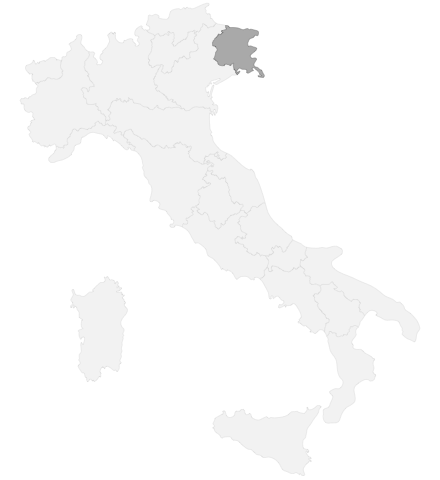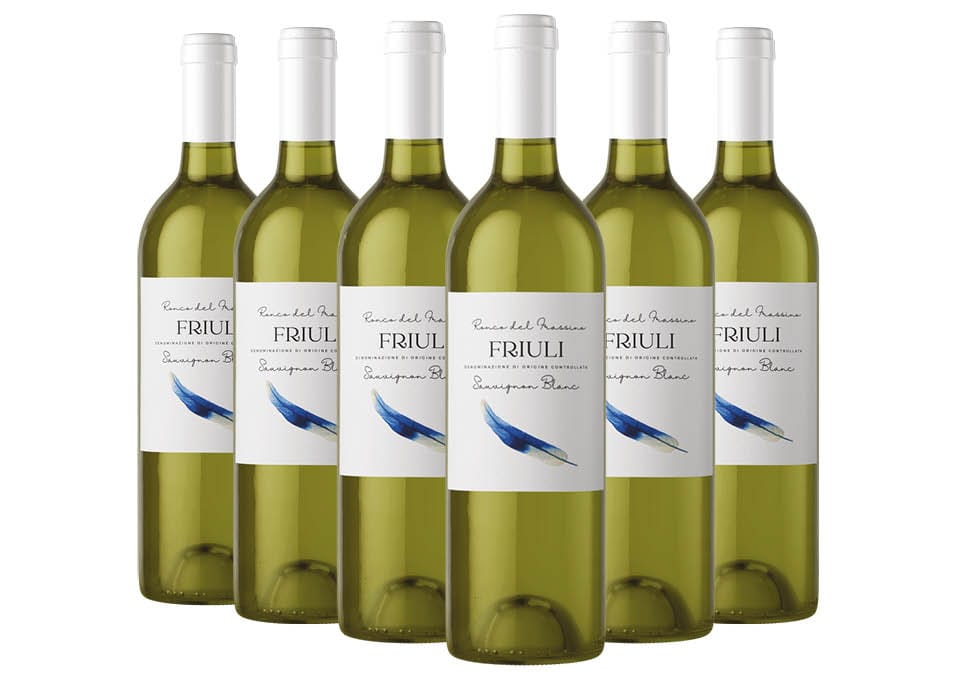Sauvignon Blanc, Friuli Venezia Giulia
Sauvignon Blanc is one of the most loved and widespread white grape varieties in the world. It is a variety native to the Loire Valley region which gradually spread to Bordeaux as well. DNA analyzes have revealed its kinship with Savagnin, one of the oldest grapes in central Europe which could be one of the parents of Sauvignon Blanc. As a semi-aromatic variety, it is now grown in many countries around the world, most notably in New Zealand, California, Australia, Chile and South Africa. In Italy, it is mainly present in Friuli Venezia Giulia and Alto Adige. Naturally, pedoclamic conditions that vary from place to place allow Sauvignon Blanc to express its personality in a very different way. An emblematic case of the Loire are the very cold temperatures and high humidity which, in addition to the presence of waterways, allow Sauvignon Blanc to develop the typical acidity in wines from Sancerre and Pouilly-sur-Loire, also famous for its wine. Pouilly-Fumé : these are sharp wines with typical hints of gooseberry, musk, wild herbs and flint that give the palate an aromatic texture that is not easy to taste but much appreciated by connoisseurs. Reaching the Bordeaux area, with the Sémillon, Sauvignon Blanc and Muscadelle grapes, the famous botrytised wines are obtained, that is, resulting from the appearance of noble rot on the berries which gives unique flavors by combining a high acidity with a considerable amount of sugar developed as a result of the dehydration of the cluster: Sauvignon Blanc is also in this case responsible for conferring very delicate and elegant aromas. The yield of Sauvignon in Italy is also very particular, which in the areas of Collio and Colli Orientali del Friuli has found ideal environments to grow and give the best of itself. The structure of the Sauvignon from California and New Zealand is different, in which the tropical scents of white pulp fruits blend pleasantly with the typical herbaceous notes, releasing the more acidic properties of lemon peel and pomegranate in combination with wild herbs such as thyme. , sage, rosemary.
Why buy Sauvignon Blanc
Buying Sauvignon Blanc means first of all being able to familiarize yourself with one of the most widespread and famous white berried varieties in the world. The particular aromatic cut made by Sauvignon Blanc allows it to be considered as a semi-aromatic grape and, for this reason, very transversal with respect to tastes and culinary uses. Given its diffusion, buying this wine means being able to explore very diversified products and being able to deepen different local cultures, all enclosed in the great expressions of a single grape variety.
What is the origin of Sauvignon Blanc?
The origin of the name Sauvignon Blanc probably derives from sauvage (wild). There are two biotypes, that is expressions which, although belonging to the same variety, differ in some character: Sauvignon Piccolo and Sauvignon Grosso.
What are the characteristics of wine made from Sauvignon Blanc grapes?
Sauvignon Blanc produces wines with very recognizable characteristics: the color is usually straw yellow and can take on golden reflections with a fermentation or short aging in wood according to a widespread practice in the Pessac-Leognan area. In these cases the acid tones are diluted until they take on greater density and creaminess, with a pleasant worked note and more fruity scents. Sauvignon Blanc is otherwise recognizable for a marked shade of green apple, passion fruit and a herbaceous note ranging from asparagus to green pepper and basil.
What are the best combinations for Sauvignon Blanc?
Sauvignon Blanc is indicated in combination with grilled white meats, shellfish and fish such as sea bass flavored with lemon and parsley. For some it is also a valid accompaniment to risotto with asparagus, while it is the flagship wine for appetizers based on cold cuts and fresh cheeses.

Friulan wine has been able to find a wide audience of consumers in Italy and in the world, remaining faithful to its tradition and to its native vineyards. Friuli Venezia Giulia is a region with great viticultural results thanks to the peculiar physical and geographical features, with the alternation of lands overlooking the Venetian lagoon, soft hills and imposing reliefs, and the constant commitment of small and large producers who have been able to combine an ancient tradition to the most modern technologies. Among the main appellations of the region we remember Collio DOC, Friuli Colli Orientali, Friuli Grave DOC and Friuli Isonzo DOC, each with its distinct peculiarities.
Friulian Red Wine
There are examples of excellent Friulian red wine, although the region is much more famous for white wine. Probably the most famous appellation for the reds is Friuli Grave DOC, which includes wines produced in a large territory of Friuli, in the province of Udine and Pordenone, mainly characterized by soils of alluvial origin, draining and rich in pebbles and stones, which proved to be very suitable for the cultivation of the vine, in particular for the red grape varieties. Producers such as Vistorta, Fantinel , Pighin come from this area.
There is no shortage of reds even in the DOC Collio, from cabernet franc, cabernet sauvignon, merlot, pinot noir grapes. Among the native red grape varieties, the most famous is undoubtedly Refosco dal Peduncolo Rosso.
Friulian white wine
The Friulian white wine is known all over the world and one of the most interesting appellations is undoubtedly the Collio Doc, which includes the hilly territories in the province of Gorizia. Collio Doc white wines, among the most famous and appreciated in Italy and in the world, are produced with: chardonnay, malvasia istriana, pinot blanc, picolit, pinot gris, sauvignon, Friulano, and Ribolla Gialla. From this region come the wines of great wineries such as Jermann, Gravner, Schiopetto, Villa Russiz, Livon, Cormons.
Even the Friuli Colli Orientali DOC appellation identifies one of the most suitable Italian areas for the production of quality white wines. Friuli Colli Orientali DOC includes the territory of the municipalities of Attimis, Buttrio, the eastern part of Cividale, Corno di Rosazzo, Faedis, Manzano, Nimis, Povoletto, Premariacco, Prepotto, S. Giovanni al Natisone, S. Pietro al Natisone, Tarcento and Torreano in the province of Udine. It also includes the sub-areas of Cialla, Ribolla Gialla di Rosazzo, Pignolo di Rosazzo, Schioppettino di Prepotto and Refosco di Faedis. This is the land of Livio Felluga, Bastianich, Le Vigne di Zamò and Zorzettig.
Friuli Isonzo, on the other hand, is located in the eastern area of the region, south of Collio, in the alluvial plain along the Isonzo river, from which it takes its name. In addition to the exceptional climate, which alternates warm sea breezes and fresh winds from the mountains, the soils rich in chalk and clay on the left bank and the white gravel on the right bank contribute to creating optimal conditions for the production of quality wines. In particular, the wines obtained from Sauvignon Blanc and Chardonnay have brought the Isonzo to the fore, thanks also to the work of wineries such as Vie di Romans.
What are the best combinations for Friulian wine?
Friulian wine, in its various types, is perfect for any combination. The soft and delicate whites of the Isonzo are ideal to combine with simple vegetable dishes, risottos and fish and cheese appetizers, the structured whites of the Collio are more suitable for more complex dishes or with sauces, grilled fish or soups and reds, with character and great typicality, are ideal with the tastiest meat dishes of the Italian tradition.
What are the main characteristics of white Friulian wine?
The Friulian white wine stands out for its elegance and structure, especially as regards wines from international grapes such as Chardonnay and Sauvignon. Among the whites born from native grapes we cannot fail to mention the Ribolla, defined as the “white for those who love reds thanks to its structure”, and the Tocai, an excellent white perfect for fish.
What is the most famous Friulian red wine?
The most famous and representative red wine is certainly the one obtained from Refosco dal Peduncolo rosso, a grape that owes its name to the fact that the bunches have red stems.


















